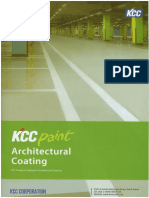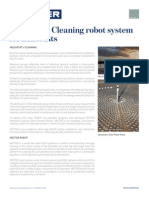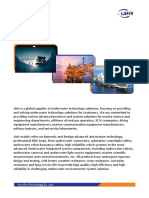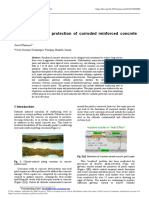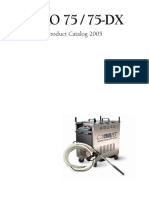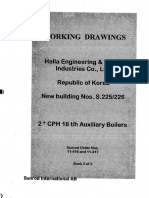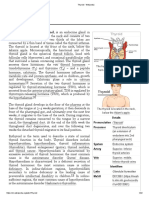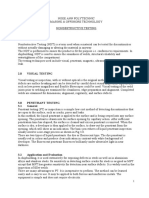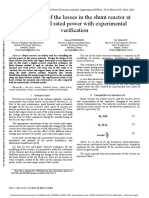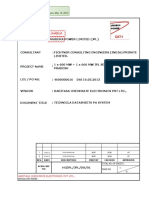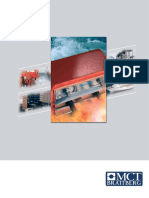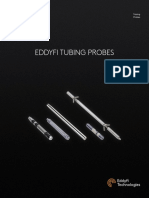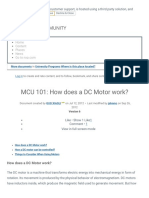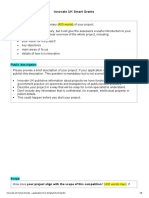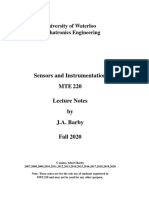Semi Automated Window Cleaning System
Semi Automated Window Cleaning System
Uploaded by
Sahil BhartiCopyright:
Available Formats
Semi Automated Window Cleaning System
Semi Automated Window Cleaning System
Uploaded by
Sahil BhartiOriginal Description:
Original Title
Copyright
Available Formats
Share this document
Did you find this document useful?
Is this content inappropriate?
Copyright:
Available Formats
Semi Automated Window Cleaning System
Semi Automated Window Cleaning System
Uploaded by
Sahil BhartiCopyright:
Available Formats
International Journal of Soft Computing and Artificial Intelligence, ISSN: 2321-404X
Volume- 1, Issue- 1
DESIGN AND DEVELOPMENT OF CLEANING SYSTEM
1
SAHIL BHARTI, 2S.R.SADHAVE, 3H.RAMKUMAR, 4S.ISHWARYA LAKSHMI
5
G.MURALIDHARAN
1,2,3,4
B.E.Production Technology Anna University, 5Head of Mechatronics Department, Anna University, MIT
Email: sahibhart@gmail.com, sadhaverajasekar@gmail.com, hramkumar21@gmail.com, ishu.jkmnvr@gmail.com,
muralig46@gmail.com
Abstract Cleaning has been a very necessary and unavoidable daily routine. It becomes even more important when we have
to perform it in areas which are not so easy in reach, Ex. High rise buildings with glass windows. In such cases conventionally
a human worker has to hang several feet above the ground with not so reliable supports and safety systems, with always a risk
of some uncertain failure and hazardous consequences, which may prove fatal.
So it necessitates the need of some safer and efficient cleaning system, which could provide cleaning, both on ground as
well as on vertical surfaces, with a control from much larger distance. So here we propose a simple but effective cleaning setup
with promising outputs addressing to the above stimulating cause.
Keywordscleaning, effective, hazardous, stimulating
I.
Platform arranged in V shape so as to ensure
efficient cleaning and collection of dust. The roller
wipers are placed at the end of the platform using
proper links and a driver motor.
The cleaning is made efficient using wet wiping
system. This system employs a small bottle that carries
water in it.
This ensures a complete cleaning of the surface. Only
the wipers in the front are made wet. This ensures that
the wiper from the back remove the water from the
surface when sweeping again on the surface.
Wall climbing is made possible using four suction
cups where the necessary negative pressure is
developed using a vacuum generator, which works on
venture principal.
The motion control involves the following:
movement
Direction control
40 rpm geared motors provide the necessary
forward motion on the floor, powered by 9V
batteries and the directional control is established
using
a
programmable
microcontroller
ATmega328 IC 32 bit, manually controlled using
Radio Frequency transmission. Infra Red sensors
are fitted on the edges for obstacle detection.
An onboard wireless camera is installed to provide
run time analysis and dirt location.
INTRODUCTION
To develop an automated cleaning assistance this
helps in cleaning flat surface with the ease of remote
control with greater efficiency at work. This is solely
aimed to replace the men at work to no man at
work.The surface cleaning machine that is proposed
in this project is the device that helps in cleaning of
surfaces and vertical walls. The automatic
surface/Window (anti-gravity) cleaning system has an
advantage of providing efficient surface/window
cleaning which can be performed semi-manned or
fully automated. Here we considered semi-manned
cleaning platform, where the directional control was
established using a remote by a human operator to
facilitate control over the machine from a distance.
METHODOLOGY
The robot is designed keeping in mind following
modules of operation.
cleaning mechanism
climbing mechanism
directional control with automatic obstacle
avoidance
In time monitoring
The cleaning is inspired from the conventional stages
of any wiping or sweeping operation, which are blend
with the design and placed in the operational order of
working stages.it consist of four dedicated wipers that
are attached to the platform. Among them, one of the
wipers is cylindrical and the others are flat in
geometry. The flat wipers are symmetrically placed at
the bottom of the
CHASIS CONSTRUCTION
Aluminum is selected for the metallic base since it
has light weight. The thickness of the chassis is 2mm.
The dimensions were decided according to the design
requirements considering complexity of construction
and and overall weight of the setup. The steps carried
out are explained as follows. Two 100mm diameter
tiers are fixed in symmetry to balance the center of
gravity of the chaise Provision for roller wiper was
Design and Development of Cleaning System
50
International Journal of Soft Computing and Artificial Intelligence, ISSN: 2321-404X
This values is sent to the Arduino for further
processing
The motion control also involves a lot of parts that
have to be connected together for effective
functioning. The various parts and their working are
specified as shown below:
The system employs a wireless network for its
operation. The wireless network is chosen for the
following reasons:
To access tall sky scrapers
To clean the floor in inaccessible areas.
To give ease of operation
The wireless control involves the transmitter and
receiver module to transmit and receive the data. The
basic working of the wireless module involves the
following components:
RF receiver module
RF transmitter module
Encoder IC (HT12E)
Decoder IC (HT12D)
made by making holes. The thin flat wipers that are v
shaped were screwed to the chassis to adjust the
height. The roller wiper is placed at the back inside the
chassis. The two thin flat wipers are attached to the
middle portion of the chassis. These two wipers are
attached in a v shape, inclined to each other. The v
shape ensures that the dust is transferred to same spot
after cleaning, making the duct collection part for
floor cleaning very easy. The bumper present at the
front collects big particles. The wiper at the front that
wets touches the ground lightly to apply water. The
next wiper collects dust that is larger in size. The third
wiper collects dust smaller than the previous one and
so forth. These vipers are provided with a screw
attachment such that it allows an advantage of
adjusting height as per the surface unevenness. The
roller wipers are rotated using 100rpm motors. This
cleans the dust along the path that the vehicle moves.
II.
Volume- 1, Issue- 1
MOTION CONTROL
There are many functions that have to co-ordinate
for the motion control. They involve the following
functions:
Moves the vehicle on both floor and wall.
Turns the base to desired direction.
Detects the obstacles and stops moving
The entire wired set up is placed on the platform
that is above the chassis. The platform is very well
insulated using the card board like structure. This
portion is completely separated from the rest of the
setup. This avoids any short circuiting, thus
preventing any internal shocks.
The movement and the direction control are
directed by means of various components. The motion
control involves the series of the following steps:
The operator gives command (Forward/
Backward/ Left turn/ Right turn) through the push
buttons.
Based on the command that is pressed, the push
button send out a set of codes. E.g. If the first push
button is pressed, in this case it carries a value of
LOW or 0. Thus the set of codes that is sent is
0111.
This code is sent in parallel combination to the
transmitter circuit.
The transmitter IC (HT12E), the encoder,
encodes this set of data and send the code to the
transmitter serially through a set of RF waves
The transmitter will give away the signal to the
receiver through the antenna
The range of the module is approximately 100
meters
The antenna receives the RF waves at a particular
wavelength and send the code serially to the decoder
(HT12D)
The decoder decodes the signal and in turn gives
away the value of 0111.
Figure.1 (Transmitter and Receiver)
For RC control, we will need:
-A transmitter, which takes the form of a handset.
This, unsurprisingly, 'transmits' commands to your
RC system. If you've ever had an RC toy, this is the
part you hold in your hand.
-A receiver.. It receives the commands from the
transmitter and sends them to the output devices. One
or more output devices such as an ESC/motor combo
or servos These plug into the receiver and are usually
used to spin wheels or move control surfaces such as a
steering mechanism.
2.1. ENCODER: HT12E
HT12E is an encoder integrated circuit of 212 series
of encoders. They are paired with 212 series of
decoders for use in remote control system
applications. It is mainly used in interfacing RF and
infrared circuits. The chosen pair of encoder/decoder
should have same number of addresses and data
format.
Simply put, HT12E converts the parallel inputs
into serial output. It encodes the 12 bit parallel data
into serial for transmission through an RF transmitter.
These 12 bits are divided into 8 address bits and 4 data
bits.
HT12E has a transmission enable pin which is
active low. When a trigger signal is received on TE
Design and Development of Cleaning System
51
International Journal of Soft Computing and Artificial Intelligence, ISSN: 2321-404X
Volume- 1, Issue- 1
pin, the programmed addresses/data are transmitted
together with the header bits via an RF or an infrared
transmission medium. HT12E begins a 4-word
transmission cycle upon receipt of a transmission
enable. This cycle is repeated as long as TE is kept
low. As soon as TE returns to high, the encoder output
completes its final cycle and then stops.
human eyes. The wavelength region of 0.75m to 3
m is called near infrared, the region from 3 m to 6
m is called mid infrared and the region higher than 6
m is called far infrared.
The wireless sensors involve the following
components and steps:
(Figure.3)
2.2 Decoder: HT12D
HT12D is a decoder integrated circuit that belongs
to 212 series of decoders. This series of decoders are
mainly used for remote control system applications,
like burglar alarm, car door controller, security system
etc. It is mainly provided to interface RF and infrared
circuits. They are paired with 212 series of encoders.
In simple terms, HT12D converts the serial input
into parallel outputs. It decodes the serial addresses
and data received by, say, an RF receiver, into parallel
data and sends them to output data pins. The serial
input data is compared with the local addresses three
times continuously. A valid transmission in indicated
by a high signal at VT pin.HT12D is capable of
decoding 12 bits, of which 8 are address bits and 4 are
data bits.
Infrared Source
All objects above 0 K radiate infrared energy and
hence are infrared sources. Infrared sources also
include blackbody radiators, tungsten lamps, silicon
carbide, and various others.
2.3
Transmission Medium
Three main types of transmission medium used for
Infrared transmission are vacuum, the atmosphere,
and optical fibers. Due to absorption by molecules of
water carbon dioxide, ozone, etc. the atmosphere
highly attenuates most IR wavelengths leaving some
important IR windows in the electromagnetic
spectrum; these are primarily utilized by thermal
imaging/ remote sensing applications.
IR Sensors
Optical components
Often optical components are required to converge
or focus infrared radiations, to limit spectral response,
etc. To converge /focus radiations, optical lenses made
of quartz, CaF2, Ge and Si, polyethylene Fresnel
lenses, and mirrors made of Al, Au or a similar
material are used. For limiting spectral responses,
band pass filters are used. Choppers are used to pass/
interrupt the IR beams.
(Figure.2)
The IR sensors are used for the obstacle
detection. These are sent as the input values for the
Arduino microcontroller board along with the push
button signals received from the RF transmission. The
IR sensors works according to the following:
The IR sensors emit IR rays continuously in a
line.
The rays transmitter and detector are present in
the same board.
Once any object comes as an obstacle, the IR rays
are reflected back to the source
These rays are detected and an output signal Is
sent.
This signal is sent to the arduino board for further
processing
Infrared radiation is the portion of electromagnetic
spectrum having wavelengths longer than visible light
wavelengths, but smaller than microwaves, i.e., the
region roughly from 0.75m to 1000 m is the
infrared
region. Infrared waves are invisible to
Infrared detectors
Wavelength region or temperature to be measured,
response time, cooling mechanism, active area,
number of elements, package, linearity, stability,
temperature characteristics, etc. are important
parameters which need attention while selecting IR
detectors.
Signal Processing
Since detector outputs are typically very small,
preamplifiers with associated circuitry are used to
further process the received signals.
2.4 ARDUINO UNO BOARD.
Design and Development of Cleaning System
52
International Journal of Soft Computing and Artificial Intelligence, ISSN: 2321-404X
Volume- 1, Issue- 1
This is because the power obtained from the
controller is very small.
It is only about 5 volts.
But the motors require 12 volts for their
operation.
So the motor driver board acts as the intermediate
component.
L293 is the ic used in this driver board
For this to work the inputs and outputs of are
specified in the form of a block diagram as shown
above:
(Figure 4)
This is the micro controller that controls the
action of the entire motion control of the cleaning
system. This controller decides the way in which the
entire set up should turn depending on the presence of
the obstacles.
The arduino board has the following steps:
The controller receives inputs from the IR
sensors and the Push button signals.
The signals are analyzed
A program is already fed into the Arduino board
IC to perform a certain task
For example, if the input signal is received as
0111, then the chassis is destined to do forward
movement. So signals are sent out to the driver board
accordingly.
In case of the IR sensors, the signals when
received are supposed to stop the motor. Thus no
supply signal is given to the motor.
The program is fed into the arduino board
through software specially designed for this board.
The software is ARDUINO IDE that can be
installed in any system with its basic configuration.
The output from this goes to the motor driver
board.
The processor uses here is ATMEGA 328D.
The main function of this processor is to decode the
information received from the pushbuttons and the IR
sensors and send the signals to the motor driver board
for actuation of the motors.
The Arduino Uno is a microcontroller board based
on the ATmega328. It has 14 digital input/output pins
(of which 6 can be used as PWM outputs), 6 analog
inputs, a 16 MHz ceramic resonator, a USB
connection, a power jack, an ICSP header, and a reset
button. It contains everything needed to support the
microcontroller; simply connect it to a computer with
a USB cable or power it with an AC-to-DC adapter or
battery to get started.
Uno means one in Italian and is named to mark
the upcoming release of Arduino 1.0. The Uno and
version 1.0 will be the reference versions of Arduino,
moving forward. The Uno is the latest in a series of
USB Arduino boards, and the reference model for the
Arduino platform.
(Figure 5)
The motor driver board contains an IC that converts
the input given to the board to pulses that operate the
motors. The input for this board is obtained from the
Arduino Uno board and the output is given to the
motors. The electrical signals are given to the motors.
The motors must have opposite electrical signals in
their poles to enable their running. For example, to
run the first motor, a low signal has to be given to one
pole and high signal to the other pole.
2.6. Motors
(Figure.6)
Motors are the primary actuators for any system. They
move the entire vehicle in the desired direction. The
motors have two poles that have to be given supply to
rotate it. Among the two poles, one has to get the
required power supply while the other gets the ground.
Due to opposite charges given to them, the core starts
rotating in the desired directing giving the output.
This is the basic operation for any motor. Desired
motion like and left turns can be achieved by powering
the poles accordingly.
The various parts that require motor and their
specifications are as follows,
PART
VOLTAGE RPM
MOTOR
NAME
NEEDED
NEEDED
2.5 Motor Driver Boards
Motors cannot be operated directly from the
signal obtained from the controller.
TYRES
12V
40
ROLLER
WIPERS
12V
100
TABLE 1
Design and Development of Cleaning System
53
International Journal of Soft Computing and Artificial Intelligence, ISSN: 2321-404X
Geared motors are used for the application here.A
gear motor is a device which allows
low-horsepower motors to drive a great deal of force
on an object with low speed. It consists of a reduction
gear train and an electric motor, which both come
fully integrated into an easily mountable and
configurable system. The benefit of using
gear motors is that they simplify the design and
manufacturing of power tools and machines which
require high torque, or moment of force, at low shaft
speeds or at low revolutions per minute speeds.
The logical conditions for the motor to work are
given in the form of a truth table:
Condition
Forward
Backward
Right
Left
III.
Motor
A1
High
Low
High
Low
Motor
Motor
A2
B1
Low
High
High
Low
Low
Low
Low
High
(Table 2)
Volume- 1, Issue- 1
sponge wiper, where it percolates down through a
perforated pipe chamber on to the floor. The overflow
of water is corrected by proper knobs. A tube runs
from the small tank to the entire length of the
perforated wiper at the front. This wets the surface.
The remaining wipers take away the dirt from the
floor and the final roller wiper collects the dirt water
from the surface and dry similar to a moping action.
Motor
B2
Low
High
Low
High
(Figure. 8)
IV.
WALL CLIMBING MECHANISM
CLEANING SYSTEM
(Figure 7)
1: flat sponge wiper (stage 1. Wetting)
2: flat wiper hardened sponge (stage 2: larger duct
collection)
3: flat wiper hardened sponge (stage 3: finer duct
collection)
4: roller wiper (stage 3: mopping and finishing)
The cleaning mechanism takes place by 4 wipers that
are attached at the bottom. Among them, 3 wipers are
flat and the other one is roller. The flat wipers are
symmetrically placed at the bottom of the platform.
They are placed in a V shape so as to ensure that the
dirt water falls down along the wiper when it moves
along the walls in every particular direction. The
roller wiper is placed at the end of the platform using
proper links; this is driven by motor at a higher rate in
the opposite direction to the direction of vehicle
propagation. The wipers in the middle are connected
by means of a screw which can be adjusted and
removed whenever needed.
The cleaning is made efficient using wet wiping
system. This system employs a small water storage
tank and a 12V DC submergible pump creates the
water flow through the pipes straight to the front
(Figure 9)
The wall climbing is the most crucial part of the entire
system. The wall climbing has to be made very
carefully. The wall climbing mechanism is created
using the pneumatic system. The following
components are employed to make the robot climb the
wall:
Double acting cylinder (16cm dia., 5cm stroke
length)
Suction Cups
Direction Control valve
Compressor
Vacuum generator
The wall climbing mechanism is made successful
by the pneumatic cylinders. The piston of the cylinder
is attached to the bumper of the vehicle. The vehicle
bumper is used to collect dirt of very large size, so that
it does not get struck inside the wipers. The suction
cups are placed at the four corners of the vehicle. The
system works as follows:
As the piston in the cylinder expands, the bumper
gets pushed forward.
Design and Development of Cleaning System
54
International Journal of Soft Computing and Artificial Intelligence, ISSN: 2321-404X
During this process the suction cup at the back
holds the vehicle.
After the bumper is pushed, the suction cup at the
front holds the wall through suction, while the suction
cups at the back releases.
Then the cylinder retracts, pulling the entire
chassis.
After retraction, the suction cups at the back
engage, whereas the suction cups at the front
disengages.
The above steps are repeated for climbing the
wall.
The suction cups are alternatively operated by
controlling the dcv. The various parts of this wall
climbing mechanism are explained in detail below
4.1.
The cups are made for discontinuous suction.
The sequence in which the suction is carried out
is controlled by the dcv. A suction cup is a device,
usually in the shape of a cup and made of plastic or
rubber, which is designed to adhere to a flat surface
through suction. Suction cups are a big part of
industry, with uses ranging from hanging products on
windows to actually transporting large items. Suction
cups have been used by people to climb buildings and
to keep glass from falling when holes are cut in it.
The concept that is most important, and what
makes a suction cup bond strong, is the creation of a
vacuum. When a suction cup is pressed against a
surface, it pushes out all of the air beneath it and
creates a vacuum between the cup and the surface.
This vacuum holds the suction cup tightly, and it will
continue to do so until the pressure on the outside of
the cup becomes lower than the pressure on the inside
of the cup.
When a suction cup is removed, it creates a loud,
popping sound. That is the sound of the air rushing in
to fill the vacuum that the suction cup created. A
suction cup that is flexible, such as those made of
rubber or PVC, can be stretched and tugged while still
maintaining its vacuum.
Double acting cylinder
Pneumatic cylinders (sometimes known as air
cylinders) are mechanical devices which use the
power of compressed gas to produce a force in a
reciprocating linear motion. Something forces a
piston to move in the desired direction. The piston is a
disc or cylinder, and the piston rod transfers the force
it develops to the object to be moved. Because the
operating fluid is a gas, leakage from a pneumatic
cylinder will not drip out and contaminate the
surroundings, making pneumatics more desirable
where cleanliness is a requirement.
Double-acting cylinders (DAC) use the force of air
to move in both extends and retract strokes. They have
two ports to allow air in, one for outstroke and one for
in stroke. Stroke length for this design is not limited;
however, the piston rod is more vulnerable to buckling
and bending. The chassis held on the wall through
suction cups. The suction cups are held on the bumper
structure. The entire action takes place with the to and
fro action of the pneumatic double acting cylinder.
The pneumatic cylinder is held at the center of the
chassis. The end of the double acting cylinder is
connected to the bumper. This to and fro action
controls the movement of the vacuum cups.
(Figure 10)
To calculate the force of a suction cup, use the
formula:
F=P.A
Where F = force, A = area, P= pressure.
The vacuum in generated through the vacuum
generator. Direction control valve actuates the
selection of the vacuum cups to be actuated at certain
time. The compressor generates the compressed air for
the actuation of the entire system. Two direction
control valves are used to actuate the wall climbing
mechanism.
4.2.
Volume- 1, Issue- 1
4.3. Direction Control Valve
Directional control valves allow fluid flow into
different paths from one or more sources. They usually
consist of a spool inside a cylinder which is
mechanically or electrically controlled. The
movement of the spool restricts or permits the flow,
thus it controls the fluid flow.
Suction Cup
The suction cups enable the body to go up the
wall.
The suction cups make use of vacuum generators.
The vacuum generators create vacuum suction.
Design and Development of Cleaning System
55
International Journal of Soft Computing and Artificial Intelligence, ISSN: 2321-404X
Solenoid operated valves make use of
electromechanical Solenoids for sliding of the spool.
Because simple application of electrical power
provides control, these valves are used extensively.
However, electrical solenoids cannot generate large
forces unless supplied with large amounts of electrical
power. Heat generation poses a threat to extended use
of these valves when energized over time.
4.4
spinning impeller to accelerate and then decelerate
captured air, which pressurizes it.
V.
FORCE CALCULATION
Calculation of the speed of the model:
The rpm of the motor taken into consideration: 40
rpm
Diameter of the tire: 100 mm
The distance that is covered in one revolution of the
tire
Is equal to the circumference of the tire.
The Circumference = 2r
= 2 * * 100 mm
= 628.32 mm
The distance covered in one revolution = 628.32
mm
Hence the distance covered in 40 revolution = 40 *
628.32 mm
= 25132.8 mm
The distance covered in one minute is 25132.8 mm
or
25 m
Or the speed = 25 / 60 (m/s)
= 1.5 kmph
The speed can be varied according to the customers
requirement.
Vacuum suction force
Vacuum Generators
Vacuum generators are used to create vacuum
inside the suction cups that are used to hold the entire
chassis. The vacuum generators work on the venturi
principle:
Venturi effect is a result of a reduction of pressure
that leads to increased speed. Easy example is a pipe,
with a tightened center. The point is that the fluid
speed through the constriction will be faster. However
you will also get a drop though in pressure. It happens
because of the law of conservation of mass, and energy
respectively.
Steps in vacuum generation are shown as follows:
Each vacuum cup can hold a mass of 0.8 kg. So, 4
cups can hold 0.8*4=3.2kg
The weight of the entire set up = 2.1 kg
The diameter of the suction cups = 40mm
(Figure.11)
Compressed air flows through the inlet (1),
Then through a single directed nozzle (2).
As the airstream exhausts, it expands and
increases in velocity prior to passing through the
venturi (3).
A vacuum inlet tangential to the primary airflow
(4) is located at the suction point between the orifice
and the venturi.
The airflow that is drawn through the vacuum
inlet mixes with the primary airstream, then exhausts
on the opposite end (5).
4.5.
Volume- 1, Issue- 1
VI.
APPLICATION
Cleaning the windows of sky scrapers
A floor cleaning assistant at home and
commercial areas
Inaccessible areas that are underneath sofas and
beds can be cleaned
Black boards, smooth walls and any kind of flat
surface can be cleaned.
RF control is for safe high altitude reach for
cleaning.
Compressor
VII.
An air compressor is a device that converts power
(usually from an electric motor, a diesel engine or a
gasoline engine) into kinetic energy by compressing
and pressurizing air, which, on command, can be
released in quick bursts. There are numerous methods
of air
compression,
divided into either
positive-displacement or negative-displacement.
Positive-displacement air compressors work by
forcing air into a chamber whose volume is reduced to
compress the air. Negative-displacement air
compressors use centrifugal force generated by a
LIMITATIONS
Suitable for only flat surfaces
The transmission occurs at the rate of 1Kbps 10Kbps
Semi-automated
VIII.
FUTURE ADDITIONS
The model that is present in the report above can be
optimized as much as possible. The recommended
additions are:
Design and Development of Cleaning System
56
International Journal of Soft Computing and Artificial Intelligence, ISSN: 2321-404X
The chassis can be built on a PVC polymer. This
will reduce the overall weight of the system
The suction part can be automated using
Programmable Logic Control for the sequence of
operation
The setup can be fully automated without manual
interventions
The dust can be collected using vacuum removal
Image processing technique can b implied to
analyses the surface cleaning efficiency using a high
quality on board camera
Germ less cleaning using UV exposure installed
on the vehicle.
Volume- 1, Issue- 1
This contemporary design helps to overcome the
limitations of the existing technologies and surpass
them in terms of robot capability, modularity and
payload. By integrating on the modular design the
wall climbing robot are expected to attain superior
intelligence to other small robots in similar caliber.
REFRENCES
[1].Dong Sun, Jian Zhu and Shiu Kit Tso (2007) A Climbing Robot
for Cleaning Glass Surface with Motion Planning and Visual
Sensing Climbing and Walking Robots, Book edited by
Houxiang Zhang ISBN978-3-902613-16-5, pp.546
[2]. F.Cepolina, R.Michelini, R. Razzoli, M. Zoppi, (2003) Gecko,
AVlimbing Robot forWallCleaning, 1st International Workshop
onAdvances in service Robotics ASER03, March 13-15,
Bardolino, Italia, 2003
[3]. Tohru Miyake, Hidenori Ishihara, Ryu Shoji and Shunichi
Yoshida (2006) Development of Small-Size window Cleaning
Robot by Wall Climbing Mechanism ISARC2006.
[4]. Weiguang Dong, Hngguang Wang, Aihua Liu and Zhenhui Li
(2010) Design and Analysis of a Novel Wall-climbing Robot
Mechanism.
RESULTS AND DISCUSSION
A mechanical setup is designed with the synergies
of pneumatics and electronics to provide efficient
cleaning system both at ground and as well as window
levels.
Design and Development of Cleaning System
57
You might also like
- Bang Mau KCC 2021Document5 pagesBang Mau KCC 2021Trường NguyenNo ratings yet
- Catalogue For DaiHan Anchor Chain MFGDocument20 pagesCatalogue For DaiHan Anchor Chain MFGthlim19078656No ratings yet
- Hector PDFDocument2 pagesHector PDFGugui MagunaNo ratings yet
- Unir-Cables SubmarinosDocument14 pagesUnir-Cables SubmarinosManuel NavaNo ratings yet
- Inductively Coupled Plasma - Chemical Vapor Deposition (ICP-CVD)Document6 pagesInductively Coupled Plasma - Chemical Vapor Deposition (ICP-CVD)Hitesh KambleNo ratings yet
- Galvanic Cathodic Protection of Corroded ReinforceDocument6 pagesGalvanic Cathodic Protection of Corroded ReinforceIndar WatiNo ratings yet
- Voltage Stability in Electrical Power Systems Concepts, Assessment, and Methods For Improvement - 2022 - KarbalaeiDocument282 pagesVoltage Stability in Electrical Power Systems Concepts, Assessment, and Methods For Improvement - 2022 - KarbalaeiwangyuanNo ratings yet
- LED EDGE Plus Street Lighting - BajajDocument2 pagesLED EDGE Plus Street Lighting - Bajajsoumya mondalNo ratings yet
- 06-MS-ME - Mechanical Properties of MetalsDocument51 pages06-MS-ME - Mechanical Properties of Metalsfarah Al-zgoulNo ratings yet
- Government Calibration Hierarchy in IndiaDocument3 pagesGovernment Calibration Hierarchy in IndiaNAYEEMNo ratings yet
- Onkyo HT r391Document82 pagesOnkyo HT r391Eustalio PelasNo ratings yet
- Power Generation by Vertical Axis Wind Turbine and Solar EnergyDocument10 pagesPower Generation by Vertical Axis Wind Turbine and Solar EnergyIJRASETPublicationsNo ratings yet
- ComPact NS - 33484Document3 pagesComPact NS - 33484ahmedalgaloNo ratings yet
- Cold Jet AeRO 75 Series Catalog 2005Document8 pagesCold Jet AeRO 75 Series Catalog 2005TitexPlusNo ratings yet
- Limit Switching Wshex 10.2 - Wshex 16.2 For Manually Operated ValvesDocument40 pagesLimit Switching Wshex 10.2 - Wshex 16.2 For Manually Operated ValvesAnggi DwiyantoNo ratings yet
- M49 Boiler Control 2-3Document216 pagesM49 Boiler Control 2-3Ajit PrabhakaranNo ratings yet
- ThyroidDocument22 pagesThyroidTejas HankareNo ratings yet
- Final MINUTES For 63rd ESC Meeting 17.03.2020Document59 pagesFinal MINUTES For 63rd ESC Meeting 17.03.2020Girish YadavNo ratings yet
- Laser Welding of Ti6Al4V Titanium AlloysDocument9 pagesLaser Welding of Ti6Al4V Titanium Alloysadnan domlogeNo ratings yet
- Project ReportDocument22 pagesProject ReportMEHRAN KAPRANo ratings yet
- Smart: What A Smart Grid IsDocument16 pagesSmart: What A Smart Grid IsRaghavendra RaghuNo ratings yet
- Electrical Design Project of A Small Bakery - EEPDocument13 pagesElectrical Design Project of A Small Bakery - EEPSoe Min TunNo ratings yet
- Development of An Improved Earthing Method For Power and Distribution Transformers SubstationsDocument7 pagesDevelopment of An Improved Earthing Method For Power and Distribution Transformers Substationsmajed al.madhajiNo ratings yet
- Recommendations For Testing DC Extruded Cable Systems For Power Transmission at A Rated Voltage Up To 500 KVDocument36 pagesRecommendations For Testing DC Extruded Cable Systems For Power Transmission at A Rated Voltage Up To 500 KVBilly ConnorNo ratings yet
- Earth-Fault and Short-Circuit Indicator Type: Elektro-MechanikDocument5 pagesEarth-Fault and Short-Circuit Indicator Type: Elektro-MechanikMarius NagyNo ratings yet
- Mas90 Boi v20Document196 pagesMas90 Boi v20Paul MaldonatoNo ratings yet
- OMV-InDOIL General Digitalni KatalogDocument194 pagesOMV-InDOIL General Digitalni KatalogthanhluanvtNo ratings yet
- NDTDocument18 pagesNDTtxjiangNo ratings yet
- Annexure To SOW 3 STD Specification For Welding and NDT PipingDocument15 pagesAnnexure To SOW 3 STD Specification For Welding and NDT PipingASHISH GORDENo ratings yet
- 15 MW Hydropower GansuDocument31 pages15 MW Hydropower Gansuhumane28No ratings yet
- GCC M1 Specifications - v1.5-AR (Saudia)Document41 pagesGCC M1 Specifications - v1.5-AR (Saudia)hina babar aliNo ratings yet
- Session From Session To Class Section: Student I-Card and DetailsDocument3 pagesSession From Session To Class Section: Student I-Card and DetailsKhyati SehgalNo ratings yet
- 823 (August, 2019)Document830 pages823 (August, 2019)SalikNo ratings yet
- PCC LP No. 2 DTD 1st May 2018Document8 pagesPCC LP No. 2 DTD 1st May 2018Srinivas KosuruNo ratings yet
- Technical Manual Goodman GMVC8Document24 pagesTechnical Manual Goodman GMVC8ed wNo ratings yet
- Rajasthan State Wide Area Network RajswanDocument20 pagesRajasthan State Wide Area Network Rajswanranraj810% (1)
- SM-A305F Common EPLIS 11Document54 pagesSM-A305F Common EPLIS 11Doruk AslanoğluNo ratings yet
- PALL Technical DescriptionDocument8 pagesPALL Technical Descriptionoscar alfredoNo ratings yet
- Solar SystemsDocument55 pagesSolar SystemsG3MER --No ratings yet
- JucePump ChargerDocument4 pagesJucePump ChargerWill Gabriel AmbichoNo ratings yet
- Chapter 1Document37 pagesChapter 1playerNo ratings yet
- Calculation of The Losses in The Shunt Reactor at Nominal and Rated Power With Experimental VerificationDocument5 pagesCalculation of The Losses in The Shunt Reactor at Nominal and Rated Power With Experimental VerificationİSMET KAYMAZNo ratings yet
- Pod HandlerDocument13 pagesPod HandlerASWINNo ratings yet
- List of Items: 11 KV, VCB, 1250 A, Icog PanelDocument40 pagesList of Items: 11 KV, VCB, 1250 A, Icog Panelkeglobal100% (1)
- 020511-Clarification - Revised Technical Datasheets For JPL Project - CAT-IDocument46 pages020511-Clarification - Revised Technical Datasheets For JPL Project - CAT-ISunny SharmaNo ratings yet
- Delta VFD L User ManualDocument16 pagesDelta VFD L User Manualdthi160880% (1)
- 01 MCT Brattberg Uk CatalogueDocument63 pages01 MCT Brattberg Uk Cataloguefrank vanegasNo ratings yet
- Vibration-Modal Analysis Model For Multi-Span Pipeline With Different Support ConditionsDocument7 pagesVibration-Modal Analysis Model For Multi-Span Pipeline With Different Support ConditionsLK AnhDungNo ratings yet
- REVIEW Development of DRsDocument17 pagesREVIEW Development of DRsnozue.tatsuhiro nozueNo ratings yet
- Eddyfi Technologies Tubing Probes 01Document36 pagesEddyfi Technologies Tubing Probes 01abdNo ratings yet
- Frequency Response: 大同大學電機系 黃淑絹 副教授 schuang@ttu.edu.twDocument88 pagesFrequency Response: 大同大學電機系 黃淑絹 副教授 schuang@ttu.edu.tw葉士肇No ratings yet
- Study On Electromagnetic Radiation of Ultra-High Voltage Power Transmission Line PDFDocument5 pagesStudy On Electromagnetic Radiation of Ultra-High Voltage Power Transmission Line PDFHugh cabNo ratings yet
- Socomec en Netys RT M Catalogue 2015Document2 pagesSocomec en Netys RT M Catalogue 2015tariktunadNo ratings yet
- MCU 101 - How Does A DC Motor Work - NXP CommunityDocument4 pagesMCU 101 - How Does A DC Motor Work - NXP CommunityErwin Lobiano BalduezaNo ratings yet
- Exercise 2 - UK Smart GrantDocument8 pagesExercise 2 - UK Smart GrantcyrilNo ratings yet
- Note 17: Metal DetectionDocument2 pagesNote 17: Metal DetectiontruongnguyenphiNo ratings yet
- MTE 220 Course - NotesDocument163 pagesMTE 220 Course - NotesqNo ratings yet
- Jetfoil - Tunnel FansDocument16 pagesJetfoil - Tunnel FansCallGRNo ratings yet
- Vehicle Speed Control Using R.F. Technology: 1 Project Report OnDocument57 pagesVehicle Speed Control Using R.F. Technology: 1 Project Report OnAvinash RanjanNo ratings yet
- Be Mech Final Project On Key Controlled ForklifterDocument42 pagesBe Mech Final Project On Key Controlled ForklifterSandesh Likhar100% (1)
- The Thermometer-From The Feeling To The InstrumentDocument4 pagesThe Thermometer-From The Feeling To The InstrumentfilepzNo ratings yet
- Solutions For High Availability and Disaster Recovery With MySQLDocument42 pagesSolutions For High Availability and Disaster Recovery With MySQLNoyeem MahbubNo ratings yet
- Mayo V SatanDocument2 pagesMayo V SatanRix MigriñoNo ratings yet
- 01204427-Modes of OperationDocument38 pages01204427-Modes of OperationSwati SharmaNo ratings yet
- Application Forms FullDocument10 pagesApplication Forms FullkitursonNo ratings yet
- Pe Health SyllabusDocument3 pagesPe Health Syllabusapi-509544221No ratings yet
- SYNOPSIS - Hospital ManagementDocument5 pagesSYNOPSIS - Hospital ManagementRahul singhNo ratings yet
- DC16 Ch01Document37 pagesDC16 Ch01Jayson PoojiNo ratings yet
- Pahunt 2014Document72 pagesPahunt 2014Mohammed AdilNo ratings yet
- Caraveo 2007Document8 pagesCaraveo 2007Karla SuárezNo ratings yet
- Tirol, Courtney Allison P. Topic: Foreign Corporations 14-0707 #132Document1 pageTirol, Courtney Allison P. Topic: Foreign Corporations 14-0707 #132Courtney TirolNo ratings yet
- Prospectus 2011Document13 pagesProspectus 2011Gerard McNallyNo ratings yet
- SEO For Startups: YCombinator February 2010Document37 pagesSEO For Startups: YCombinator February 2010randfish94% (17)
- Rock Art CaliforniaDocument28 pagesRock Art CaliforniaDiana Rocio Carvajal ContrerasNo ratings yet
- Project Report GSTDocument36 pagesProject Report GSTshilpi_suresh70% (50)
- Newton Laws - Angel and AshleyDocument4 pagesNewton Laws - Angel and Ashleyapi-438888114No ratings yet
- MODULE 1 - An Introduction To Culture and PsychologyDocument7 pagesMODULE 1 - An Introduction To Culture and Psychology21-60448No ratings yet
- Alcatel-Lucent B12 BSS OverviewDocument456 pagesAlcatel-Lucent B12 BSS OverviewAudreii GudieNo ratings yet
- Electron Config Dorm LPDocument3 pagesElectron Config Dorm LPJoric MagusaraNo ratings yet
- Jeab 1 PsDocument20 pagesJeab 1 PsDharmveer KumarNo ratings yet
- Chapter 3 - SampleDocument9 pagesChapter 3 - SampleHanah NavaltaNo ratings yet
- Petition LetterDocument3 pagesPetition LetterMay SalamanteNo ratings yet
- Peptic Ulcer DiseaseDocument2 pagesPeptic Ulcer DiseaseMichala100% (1)
- Removal of DirectorsDocument3 pagesRemoval of DirectorsD.Satya Siva DarshanNo ratings yet
- Purchase Money MortgageDocument6 pagesPurchase Money MortgageJames Bradley Stoddart100% (1)
- Test 4A: © Pearson Longman 2007Document5 pagesTest 4A: © Pearson Longman 2007saANo ratings yet
- Assessing GrammarDocument21 pagesAssessing GrammarCristian OlariuNo ratings yet
- Roller, Duane W. - The Building Program of Herod The GreatDocument177 pagesRoller, Duane W. - The Building Program of Herod The GreatNicéphore Jünge100% (2)
- Analytical Chemistry Experiment 4Document6 pagesAnalytical Chemistry Experiment 4Ngoh KexuanNo ratings yet
- SCM Case StudyDocument1 pageSCM Case StudyPranave NellikattilNo ratings yet
